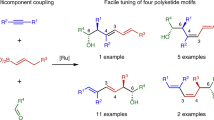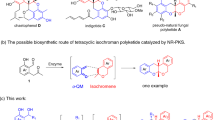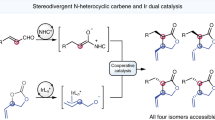Abstract
Although bacterial stereoregular polyhydroxyalkanoates have attracted broad interest as sustainable materials, it remains a long-standing challenge to chemically synthesize stereoregular polyhydroxyalkanoates via the stereoselective ring-opening polymerization of four-membered lactones. Here we report the design and synthesis of a class of readily tunable spiro-salen yttrium complexes for stereoselective ring-opening polymerization of rac-β-butyrolactone. Ligand modification on this spiro-salen system allowed a switch from syndioselectivity to isoselectivity, producing syndiotactic poly(3-hydroxybutyrate) (probability of racemic linkages between monomer units up to 0.99) and isotactic poly(3-hydroxybutyrate) (probability of meso linkages between monomer units up to 0.95). A complete stereoselectivity switch between enantiopure and racemic catalysts was observed for the spiro-binaphthol-salen system. Incorporation of rac-β-valerolactone into poly(3-hydroxybutyrate) afforded stereoregular poly(3-hydroxybutyrate-co-3-hydroxyvalerate)s with high molecular weight and desirable material properties comparable to commercial material polyolefins. This spiro-salen ligand system provides a conceptual framework that could guide future stereoselective catalyst design efforts.

This is a preview of subscription content, access via your institution
Access options
Access Nature and 54 other Nature Portfolio journals
Get Nature+, our best-value online-access subscription
$29.99 / 30 days
cancel any time
Subscribe to this journal
Receive 12 digital issues and online access to articles
$119.00 per year
only $9.92 per issue
Buy this article
- Purchase on Springer Link
- Instant access to full article PDF
Prices may be subject to local taxes which are calculated during checkout





Similar content being viewed by others
Data availability
The data supporting the findings of this study are provided in the article and its Supplementary Information or are available from the corresponding author upon reasonable request. Crystallographic data for the structures reported in this article have been deposited at the Cambridge Crystallographic Data Centre, under deposition numbers CCDC 2206620 (rac-L6, structure shown in Supplementary Fig. 145), CCDC 2206621 (rac-L7, structure shown in Supplementary Fig. 146), CCDC 2206622 [(sS, aS)-L14, structure shown in Supplementary Fig. 147] and CCDC 2206623 (rac-Y7, structure shown in Fig. 2). Copies of the data can be obtained free of charge via https://www.ccdc.cam.ac.uk/structures/.
References
Zhu, Y., Romain, C. & Williams, C. K. Sustainable polymers from renewable resources. Nature 540, 354–362 (2016).
MacLeod, M., Arp, H. P. H., Tekman, M. B. & Jahnke, A. The global threat from plastic pollution. Science 373, 61–65 (2021).
Law, K. L. & Narayan, R. Reducing environmental plastic pollution by designing polymer materials for managed end of life. Nat. Rev. Mater. 7, 104–116 (2022).
Haque, F. M. et al. Defining the macromolecules of tomorrow through synergistic sustainable polymer research. Chem. Rev. 122, 6322–6373 (2022).
De Hoe, G. X., Şucu, T. & Shaver, M. P. Sustainability and polyesters: beyond metals and monomers to function and fate. Acc. Chem. Res. 55, 1514–1523 (2022).
Müller, H.-M. & Seebach, D. Poly(hydroxyalkanoates): a fifth class of physiologically important organic biopolymers? Angew. Chem. Int. Ed. 32, 477–502 (1993).
Lenz, R. W. & Marchessault, R. H. Bacterial polyesters: biosynthesis, biodegradable plastics and biotechnology. Biomacromolecules 6, 1–8 (2005).
Chen, G.-Q. A microbial polyhydroxyalkanoates (PHA) based bio- and materials industry. Chem. Soc. Rev. 38, 2434–2446 (2009).
Muhammadi, S., Afzal, M. & Hameed, S. Bacterial polyhydroxyalkanoates-eco-friendly next generation plastic: production, biocompatibility, biodegradation, physical properties and applications. Green. Chem. Lett.Rev. 8, 56–77 (2015).
Rehm, B. H. A. Bacterial polymers: biosynthesis, modifications and applications. Nat. Rev. Microbiol. 8, 578–592 (2010).
Barouti, G., Jaffredo, C. G. & Guillaume, S. M. Advances in drug-delivery systems based on synthetic poly(hydroxybutyrate) (co)polymers. Prog. Polym. Sci. 73, 1–31 (2017).
Hazer, B. & Steinbüchel, A. Increased diversification of polyhydroxyalkanoates by modification reactions for industrial and medical applications. Appl. Microbiol. Biotechnol. 74, 1–12 (2007).
Laycock, B., Halley, P., Pratt, S., Werker, A. & Lant, P. The chemomechanical properties of microbial polyhydroxyalkanoates. Prog. Polym. Sci. 38, 536–583 (2013).
Worch, J. C. et al. Stereochemical enhancement of polymer properties. Nat. Rev. Chem. 3, 514–535 (2019).
Choi, S. Y. et al. Microbial polyhydroxyalkanoates and nonnatural polyesters. Adv. Mater. 32, 1907138 (2020).
Możejko-Ciesielska, J. & Kiewisz, R. Bacterial polyhydroxyalkanoates: Still fabulous? Microbiol. Res. 192, 271–282 (2016).
Inoue, S., Tomoi, Y., Tsuruta, T. & Furukawa, J. Organometallic-catalyzed polymerization of propiolactone. Makromol. Chem. 48, 229–233 (1961).
Westlie, A. H., Quinn, E. C., Parker, C. R. & Chen, E. Y.-X. Synthetic biodegradable polyhydroxyalkanoates (PHAs): recent advances and future challenges. Prog. Polym. Sci. 134, 101608 (2022).
Amgoune, A., Thomas, C. M., Ilinca, S., Roisnel, T. & Carpentier, J. F. Highly active, productive, and syndiospecific yttrium initiators for the polymerization of racemic β-butyrolactone. Angew. Chem. Int. Ed. 45, 2782–2784 (2006).
Ajellal, N. et al. Syndiotactic-enriched poly(3-hydroxybutyrate)s via stereoselective ring-opening polymerization of racemic β-butyrolactone with discrete yttrium catalysts. Macromolecules 42, 987–993 (2009).
Ajellal, N. et al. Polymerization of racemic β-butyrolactone using supported catalysts: a simple access to isotactic polymers. Chem. Commun. 46, 1032–1034 (2010).
Dong, X. & Robinson, J. R. The role of neutral donor ligands in the isoselective ring-opening polymerization of rac-β-butyrolactone. Chem. Sci. 11, 8184–8195 (2020).
Dong, X., Brown, A. M., Woodside, A. J. & Robinson, J. R. N-oxides amplify catalyst reactivity and isoselectivity in the ring-opening polymerization of rac-β-butyrolactone. Chem. Commun. 58, 2854–2857 (2022).
Haslböck, M. et al. Mechanical and thermal properties of mixed-tacticity polyhydroxybutyrates and their association with iso- and atactic chain segment length distributions. Macromolecules 52, 5407–5418 (2019).
Dunn, E. W. & Coates, G. W. Carbonylative polymerization of propylene oxide: a multicatalytic approach to the synthesis of poly(3-hydroxybutyrate). J. Am. Chem. Soc. 132, 11412–11413 (2010).
Yang, J.-C., Yang, J., Li, W.-B., Lu, X.-B. & Liu, Y. Carbonylative polymerization of epoxides mediated by tri-metallic complexes: a dual catalysis strategy for synthesis of biodegradable polyhydroxyalkanoates. Angew. Chem. Int. Ed. 61, e202116208 (2022).
Tang, X. & Chen, E. Y.-X. Chemical synthesis of perfectly isotactic and high melting bacterial poly(3-hydroxybutyrate) from bio-sourced racemic cyclic diolide. Nat. Commun. 9, 2345 (2018).
Tang, X., Westlie, A. H., Watson, E. M. & Chen, E. Y.-X. Stereosequenced crystalline polyhydroxyalkanoates from diastereomeric monomer mixtures. Science 366, 754–758 (2019).
Cozzi, P. G. Metal–salen Schiff base complexes in catalysis: practical aspects. Chem. Soc. Rev. 33, 410–421 (2004).
Shaw, S. & White, J. D. Asymmetric catalysis using chiral salen–metal complexes: recent advances. Chem. Rev. 119, 9381–9426 (2019).
Zhong, Z., Dijkstra, P. J. & Feijen, J. [(salen)Al]-mediated, controlled and stereoselective ring-opening polymerization of lactide in solution and without solvent: synthesis of highly isotactic polylactide stereocopolymers from racemic d,l-lactide. Angew. Chem. Int. Ed. 41, 4510–4513 (2002).
Longo, J. M., Sanford, M. J. & Coates, G. W. Ring-opening copolymerization of epoxides and cyclic anhydrides with discrete metal complexes: structure–property relationships. Chem. Rev. 116, 15167–15197 (2016).
Darensbourg, D. J. Making plastics from carbon dioxide: salen metal complexes as catalysts for the production of polycarbonates from epoxides and CO2. Chem. Rev. 107, 2388–2410 (2007).
Tschan, M. J.-L., Gauvin, R. M. & Thomas, C. M. Controlling polymer stereochemistry in ring-opening polymerization: a decade of advances shaping the future of biodegradable polyesters. Chem. Soc. Rev. 50, 13587–13608 (2021).
Plajer, A. J. & Williams, C. K. Heterocycle/heteroallene ring-opening copolymerization: selective catalysis delivering alternating copolymers. Angew. Chem. Int. Ed. 61, e202104495 (2022).
Liao, X., Su, Y. & Tang, X. Stereoselective synthesis of biodegradable polymers by salen-type metal catalysts. Sci. China Chem. 65, 2096–2121 (2022).
Zintl, M. et al. Variably isotactic poly(hydroxybutyrate) from racemic β-butyrolactone: microstructure control by achiral chromium(III) salophen complexes. Angew. Chem. Int. Ed. 47, 3458–3460 (2008).
Pang, X. et al. Breaking the paradox between catalytic activity and stereoselectivity: rac-lactide polymerization by trinuclear salen–al complexes. Macromolecules 51, 906–913 (2018).
Majerska, K. & Duda, A. Stereocontrolled polymerization of racemic lactide with chiral initiator: combining stereoelection and chiral ligand-exchange mechanism. J. Am. Chem. Soc. 126, 1026–1027 (2004).
Ovitt, T. M. & Coates, G. W. Stereoselective ring-opening polymerization of meso-lactide: synthesis of syndiotactic poly(lactic acid). J. Am. Chem. Soc. 121, 4072–4073 (1999).
Ovitt, T. M. & Coates, G. W. Stereochemistry of lactide polymerization with chiral catalysts: new opportunities for stereocontrol using polymer exchange mechanisms. J. Am. Chem. Soc. 124, 1316–1326 (2002).
Pappalardo, D., Bruno, M., Lamberti, M. & Pellecchia, C. Ring-opening polymerization of racemic β-butyrolactone promoted by salan- and salen-type yttrium amido complexes. Macromol. Chem. Phys. 214, 1965–1972 (2013).
Zhang, Y.-Z., Zhu, S.-F., Wang, L.-X. & Zhou, Q.-L. Copper-catalyzed highly enantioselective carbenoid insertion into Si−H bonds. Angew. Chem. Int. Ed. 47, 8496–8498 (2008).
Ding, K., Han, Z. & Wang, Z. Spiro skeletons: a class of privileged structure for chiral ligand design. Chem. Asian J. 4, 32–41 (2009).
Zhu, S.-F. & Zhou, Q.-L. in Privileged Chiral Ligands and Catalysts (ed. Zhou, Q.-L.) Ch. 4 (Wiley-VCH, 2011); https://doi.org/10.1002/9783527635207.ch4
Zhang, F.-H., Zhang, F.-J., Li, M.-L., Xie, J.-H. & Zhou, Q.-L. Enantioselective hydrogenation of dialkyl ketones. Nat. Catal. 3, 621–627 (2020).
Xie, J.-H., Liu, X.-Y., Xie, J.-B., Wang, L.-X. & Zhou, Q.-L. An additional coordination group leads to extremely efficient chiral iridium catalysts for asymmetric hydrogenation of ketones. Angew. Chem. Int. Ed. 50, 7329–7332 (2011).
O’Shaughnessy, P. N., Knight, P. D., Morton, C., Gillespie, K. M. & Scott, P. Chiral-at-metal organolanthanides: enantioselective aminoalkene hydroamination/cyclisation with non-cyclopentadienyls. Chem. Commun. 1770–1771 (2003).
Mulzer, M., Ellis, W. C., Lobkovsky, E. B. & Coates, G. W. Enantioenriched β-lactone and aldol-type products from regiodivergent carbonylation of racemic cis-epoxides. Chem. Sci. 5, 1928–1933 (2014).
Press, K., Goldberg, I. & Kol, M. Mechanistic insight into the stereochemical control of lactide polymerization by salan–aluminum catalysts. Angew. Chem. Int. Ed. 54, 14858–14861 (2015).
Hador, R. et al. The dual-stereocontrol mechanism: heteroselective polymerization of rac-lactide and syndioselective polymerization of meso-lactide by chiral aluminum salan catalysts. Angew. Chem. Int. Ed. 58, 14679–14685 (2019).
Peterson, A. et al. Defining stereochemistry in the polymerization of lactide by aluminum catalysts: insights into the dual-stereocontrol mechanism. J. Am. Chem. Soc. 144, 20047–20055 (2022).
Irie, R., Uchida, T. & Matsumoto, K. Katsuki catalysts for asymmetric oxidation: design concepts, serendipities for breakthroughs, and applications. Chem. Lett. 44, 1268–1283 (2015).
Cheng, J. K., Xiang, S.-H., Li, S., Ye, L. & Tan, B. Recent advances in catalytic asymmetric construction of atropisomers. Chem. Rev. 121, 4805–4902 (2021).
Lu, X.-B., Ren, W.-M. & Wu, G.-P. CO2 copolymers from epoxides: catalyst activity, product selectivity, and stereochemistry control. Acc. Chem. Res. 45, 1721–1735 (2012).
Tanahashi, N. & Doi, Y. Thermal properties and stereoregularity of poly(3-hydroxybutyrate) prepared from optically active β-butyrolactone with a zinc-based catalyst. Macromolecules 24, 5732–5733 (1991).
Policastro, G., Panico, A. & Fabbricino, M. Improving biological production of poly(3-hydroxybutyrate-co-3-hydroxyvalerate) (PHBV) co-polymer: a critical review. Rev. Environ. Sci. Biotechnol. 20, 479–513 (2021).
Bloembergen, S., Holden, D. A., Bluhm, T. L., Hamer, G. K. & Marchessault, R. H. Isodimorphism in synthetic poly (β-hydroxybutyrate-co-β-hydroxyvalerate): stereoregular copolyesters from racemic β-lactones. Macromolecules 22, 1663–1669 (1989).
Chudnovsky, A. & Sehanobish, K. in Handbook of Industrial Polyethylene and Technology (eds Spalding, M. A. & Chatterjee, A. M.) Ch. 9 (Scrivener, 2017); https://doi.org/10.1002/9781119159797.ch9
Acknowledgements
This work was supported by the National Key R&D Program of China (2021YFA1501700), the National Natural Science Foundation of China (22071163 and U19A2095), the ‘1000-Youth Talents Program’, the Fundamental Research Funds for the Central Universities (YJ201924) and the State Key Laboratory of Polymer Materials Engineering (sklpme2020-3-15). We thank M. Yang and Y. Zhou from the College of Chemistry, Sichuan University, for single-crystal X-ray diffraction analysis. We thank D. Deng from the College of Chemistry, Sichuan University, for NMR testing.
Author information
Authors and Affiliations
Contributions
J.-B.Z. conceived the project and directed the research. H.-Y.H. designed and conducted experiments related to polymer synthesis and characterizations. H.-Y.H., W.X., Y.-T.H. and K.L. designed and conducted catalyst synthesis. Z.C., H.-Y.H. and J.-B.Z. wrote the initial paper and all authors contributed to the revised paper.
Corresponding author
Ethics declarations
Competing interests
J.-B.Z., H.-Y.H. and Z.C. are inventors on China patent application 202110887204.1, submitted by Sichuan University, which covers the design and synthesis of spiro-salen complexes and their catalytic polymerization. The other authors declare no competing interests.
Peer review
Peer review information
Nature Catalysis thanks Claudio Pellecchia and the other, anonymous, reviewer(s) for their contribution to the peer review of this work.
Additional information
Publisher’s note Springer Nature remains neutral with regard to jurisdictional claims in published maps and institutional affiliations.
Supplementary information
Supplementary Information
Supplementary Figs. 1–229, Discussion and Tables 1–24.
Supplementary Data 1
CIF file for rac-L6.
Supplementary Data 2
CIF file for rac-L7.
Supplementary Data 3
CIF file for (sS, aS)-L14.
Supplementary Data 4
CIF file for rac-Y7.
Rights and permissions
Springer Nature or its licensor (e.g. a society or other partner) holds exclusive rights to this article under a publishing agreement with the author(s) or other rightsholder(s); author self-archiving of the accepted manuscript version of this article is solely governed by the terms of such publishing agreement and applicable law.
About this article
Cite this article
Huang, HY., Xiong, W., Huang, YT. et al. Spiro-salen catalysts enable the chemical synthesis of stereoregular polyhydroxyalkanoates. Nat Catal 6, 720–728 (2023). https://doi.org/10.1038/s41929-023-01001-7
Received:
Accepted:
Published:
Issue Date:
DOI: https://doi.org/10.1038/s41929-023-01001-7



